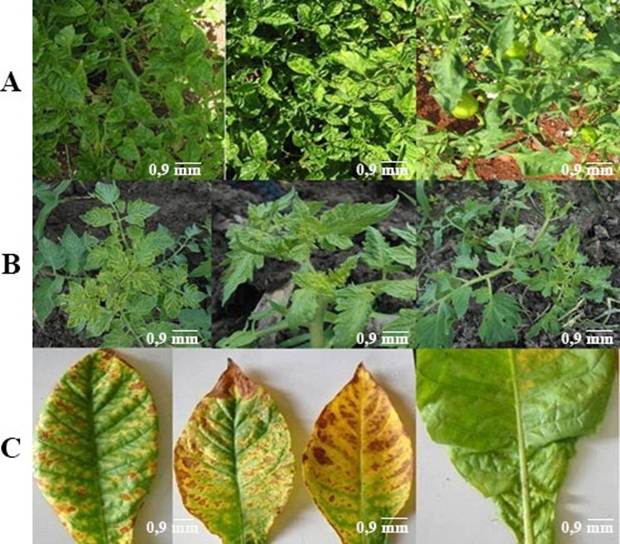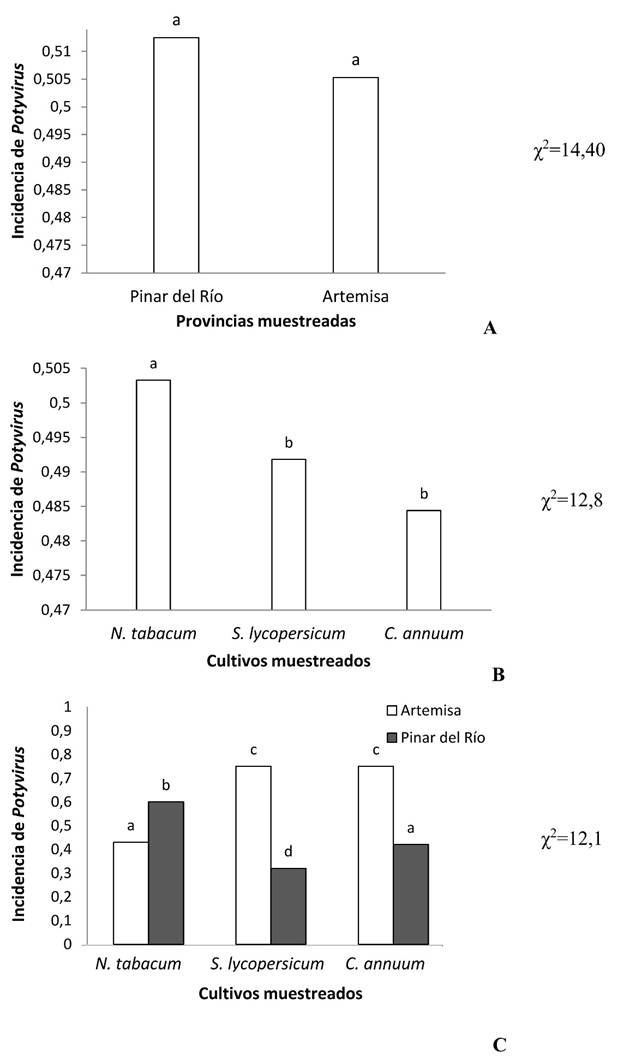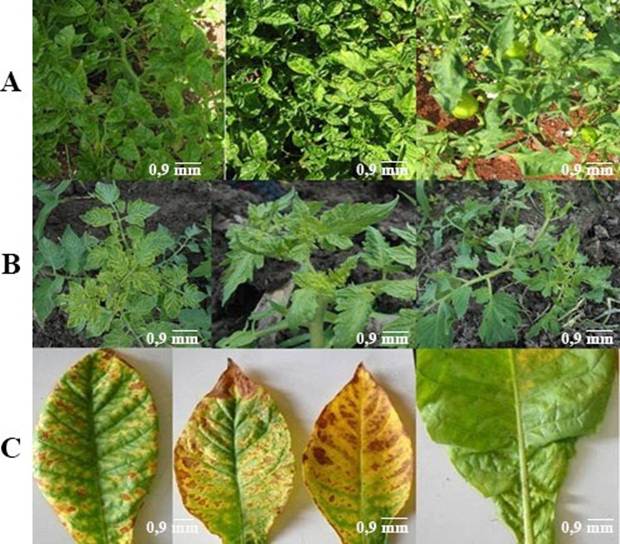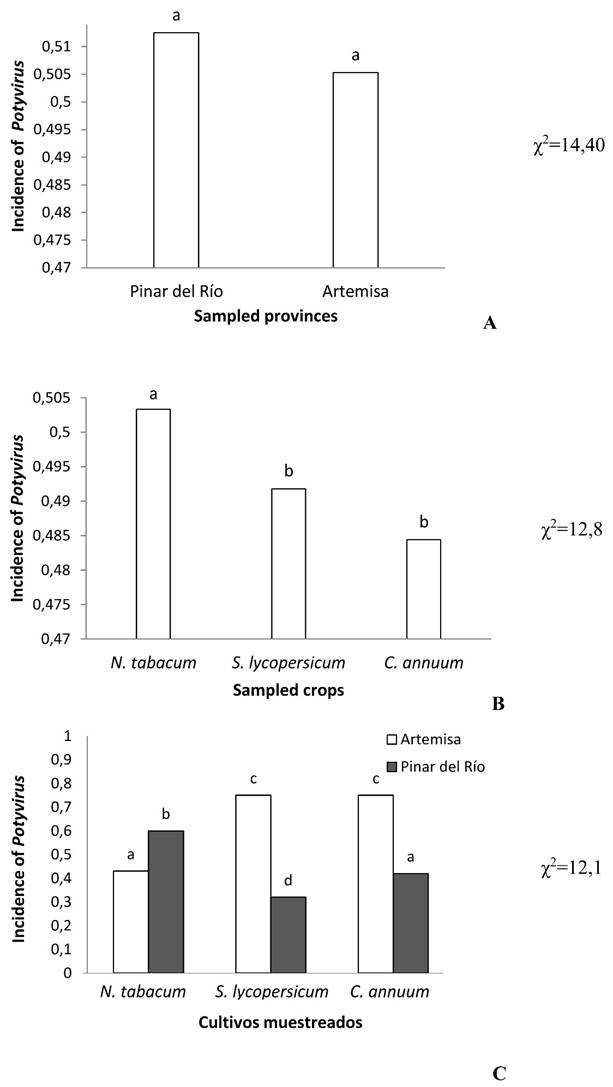Translate PaperArtículo originalIncidencia de Potyvirus en localidades productoras de solanáceas en la región occidental de Cuba
Madelaine Quiñones-Pantoja [2]
Sergio Ricardo-Desdín [3]
Annia Hernández-Rodríguez [1] [*]
[1] Departamento de Microbiología y Virología, Facultad de Biología, Universidad de La Habana
[2] Centro
Nacional de Sanidad Agropecuaria (CENSA), carretera de Jamaica y
Autopista Nacional. Apartado 10, San José de las Lajas, Mayabeque, Cuba
[3] Grupo Empresarial GEOCUBA. Cuba
[*] Autor para correspondencia. annia@fbio.uh.cu
RESUMENEl género
Potyvirus es uno de los más estudiados dentro de los virus vegetales.
Este presenta una distribución mundial y afecta a un amplio rango de
hospedantes, entre los cuales las solanáceas son las de mayor
importancia. Este trabajo tiene como objetivo determinar la incidencia
de Potyvirus en solanáceas de importancia agroeconómica en la región
occidental de Cuba empleando la técnica de ELISA indirecto. Se
recolectaron un total de 1120 muestras de hojas jóvenes de Solanum lycopersicum, Capsicum annuum y Nicotiana tabacum
(sintomáticas y asintomáticas), las que fueron evaluadas mediante ELISA
indirecto empleando anticuerpos monoclonales. Entre el 34 y el 75 % del
material vegetal recolectado resultó positivo. Los mayores valores de
incidencia (66 %) se registraron en dos localidades, situadas en los
municipios de San Juan y Martínez y San Antonio de los Baños,
respectivamente; mientras que otra, ubicada en el municipio Güira de
Melena presentó los valores más bajos (35 %).
INTRODUCCIÓNEl Virus Y de la papa (PVY) es una de las especies más patogénicas dentro del género Potyvirus, familia Potyviridae1,2. Se ha identificado como el responsable de cuantiosas pérdidas en cultivos fundamentales para la economía como Solanum lycopersicum L., Capsicum annuum L., Solanum tuberosum L. y Nicotiana sp. 3,4.
PVY está ampliamente distribuido a nivel mundial y es transmitido de
forma no persistente y no circulativa por diferentes especies de áfidos,
que se adaptan a una amplia variedad de hábitats 1.
Es
un virus desnudo, con una morfología flexuosa y filamentosa, de 740 nm
de largo y 11 nm de diámetro. Presenta un genoma constituido por una
cadena simple de ARN de polaridad positiva, de alrededor de 9,7 Kb que
contiene dos marcos abiertos de lectura flanqueados por regiones 3´ y 5´
no traducidas 5. Los síntomas causados por
PVY se relacionan, fundamentalmente, con un mosaico de color, necrosis y
arrugamiento de las hojas, aunque pueden variar en correspondencia con
la variante viral que produce la infección, las características del
hospedante, el momento de la infección o las condiciones ambientales 6,7.
En la última década, numerosos estudios han manifiestado la gran diversidad genética y biológica de PVY 8,
conjuntamente con su amplia distribución mundial, con su potencial de
recombinación y con su patogenicidad en diferentes ambientes,
representan un desafío para la agricultura. Teniendo en cuenta estos
antecedentes, se han desarrollado numerosas metodologías que tienen como
objetivo, optimizar la detección temprana del virus. Dentro de estas,
las técnicas basadas en la reacción en cadena de la polimerasa están
bien documentadas; no obstante, el empleo de esta técnica de forma
rutinaria se ve limitado por el número de muestras a evaluar, debido a
lo complejo que resulta la extracción del ARN viral 4,8.
En Cuba, diversos autores han informado de la presencia de PVY afectando a C. annuum y S. tuberosum en las provincias de Artemisa y Mayabeque 9,10.
Estos estudios emplearon, fundamentalmente, métodos tradicionales como
la observación de síntomas, con lo cual se conoce de la existencia de
cepas de PVY circulantes en diferentes regiones del país, pero se ignora
cuál es la distribución e incidencia del virus en las diferentes
localidades productoras de solanáceas. Este trabajo tiene como objetivo
determinar la incidencia de Potyvirus en solanáceas de importancia
agroeconómica en la región occidental de Cuba, empleando un ELISA
indirecto.
MATERIALES Y MÉTODOSÁrea objeto de estudioSe
determinaron las coordenadas de las 14 localidades incluidas en el
estudio, pertenecientes a las provincias de Pinar de Río y Artemisa,
empleando la tecnología de Geo-posicionamiento Global (GPS) con un
equipo SR20 (Tabla 1), según el procedimiento descrito por Ricardo-Desdín y colaboradores en 2010 11.
Toma y procesamiento de las muestrasSe recolectaron un total de 1120 muestras de hojas jóvenes de S. lycopersicum, C. annuum y N. tabacum (sintomáticas y asintomáticas) (Tabla 2),
a partir de la toma de plantas de 20 puntos específicos de un cuadrante
de 4x4 m, de acuerdo al diseño de sobre cerrado o bandera inglesa. Las
muestras se envolvieron en papel gaceta humedecido y se conservaron a 4 oC en una bolsa de nylon bien cerrada hasta el momento de ser procesadas.
ELISA indirecto para la detección de PotyvirusSe
realizó un ELISA indirecto para determinar la presencia de Potyvirus en
las muestras, de acuerdo a las instrucciones del fabricante (Agdia,
Inc, Indiana, EUA). Para ello, el tejido vegetal disponible se maceró en
bolsas de plástico, a razón de 300 mg de hoja, con 300 µL de tampón de
extracción de ELISA indirecto pH 7,4 (Na2CO3 15 mM; NaHCO3
28,4 mM; PVP 1 %) y se centrifugó durante 1 min a 7000 rpm. Se
añadieron 100 µL de extracto por pocillo en la placa de ELISA, se cubrió
con plástico transparente y se incubó a temperatura ambiente (TA)
durante 1 hora. Luego de tres lavados con PBS-Tween pH 7,4 (NaHPO4 0,02M; Na2HPO4
0,08 M; 0,15M NaCl; KCl 0,003 M y Tween-20, 10 %), se añadieron 98 µL
de la solución de anticuerpos monoclonales anti-Poty (Agdia, Inc,
Indiana, EUA) por pocillo, diluidos 1:200 en tampón conjugado (PBS 10X,
Tween-20 10 %, PVP 2 %) y se incubó a 4 °C durante toda la noche.
Posteriormente, se realizaron tres lavados con PBS-Tween, después de los
cuales se adicionaron 95 µL por pocillo de la solución de anticuerpos
conjugados (anti-ratón conjugado con fosfatasa alcalina) diluidos 1:200
en tampón conjugado y se incubó durante 1 h a TA. Se llevaron a cabo
otros tres lavados con PBS-Tween y, a continuación, se añadieron 100 µL
por pocillo de la solución de sustrato: p-nitrofenol de concentración 1
mg L-1 en tampón sustrato de fosfatasa alcalina con pH 9,8 (dietanolamina 10 %, MgCl2 6H2O 0,5 mM, NaN3
3,8 mM). Se cubrió la placa con papel de aluminio y se incubó a TA.
Finalmente se realizaron lecturas espectrofotométricas a 405 nm después
de transcurridos 30 min, 60 y 90 min de la incubación. Se utilizó un
lector de ELISA LIUYI WD-2102A.
Como controles
positivos a la infección por Potyvirus, se empleó el suministrado por el
fabricante (Agdia, Inc, Indiana, EUA) en forma liofilizada. Como
control negativo se emplearon tres muestras de tejido foliar de Arabidopsis thaliana
L., crecida en condiciones controladas en casa de cristal. Se
consideraron como positivas aquellas muestras cuyas lecturas de
absorbancia a 405 nm presentaron un valor mínimo del doble de la lectura
obtenida en el control negativo 3.
La
incidencia de Potyvirus en la población evaluada se calculó mediante el
conteo del número de plantas positivas al ELISA indirecto, dividido por
el total de plantas colectadas de acuerdo a la metodología descrita por
Gil y colaboradores en 2011 12.
Análisis biométricoPara
el análisis estadístico de los resultados, se realizaron las pruebas de
normalidad y de homogeneidad de varianza a todos los datos.
Posteriormente se utilizó una Prueba de Chi cuadrado y un análisis
bifactorial completamente aleatorizado contenidos en el paquete
STATISTICA versión 8.0.
RESULTADOSDeterminación de la incidencia de Potyvirus en las regiones geográficas muestreadasDentro
de las muestras recolectadas se encontraron plantas con síntomas
típicos de Potyvirus como mosaico, arrugamiento de las hojas,
decoloración internervial, amarillamiento y necrosis (Figura 1).
Plantas
sintomáticas recolectadas en el estudio que muestran arrugamiento,
mosaico, decoloración internervial, amarillamiento y necrosis. A) C. annuum. B) S. lycopersicum. C) N. tabacum
Los resultados pusieron de manifiesto la
alta incidencia de Potyvirus en las zonas evaluadas. Entre el 34 y el 75
% del material vegetal recolectado resultó positivo mediante el ensayo
de ELISA Indirecto (D.O. 0,5-1,2) (Tabla 3). Los
mayores valores se registraron en las localidades tres y nueve situadas
en los municipios de San Juan y Martínez y San Antonio de los Baños,
respectivamente; mientras que la localidad 14 situada en el municipio
Güira de Melena presentó los valores más bajos (35 %).
Al realizar la comparación general entre
ambas provincias (Pinar del Río y Artemisa) no se detectaron diferencias
significativas en cuanto a la incidencia de Potyvirus para p≤0,05 (Figura 2A). El nivel de incidencia en N. tabacum difiere significativamente de S. lycopersicum y C. annuum, mientras que no se evidencian diferencias entre los valores detectados en S. lycopersicum y C. annuum para p≤0,05 (Figura 2B). La incidencia de este género viral para N. tabacum,
en Pinar del Río es mayor que en Artemisa; sin embargo, para los otros
dos cultivos es superior en Artemisa. A su vez, no se detectaron
diferencias significativas entre S. lycopersicum y C. annuum en cuanto a respuesta a Potyvirus, tanto en Artemisa como en Pinar del Río (p≤0,05) (Figura 2C).
Incidencia
de Potyvirus. A) En la región geográfica de estudio. B) En los tres
cultivos muestreados. C) En los tres cultivos por cada provincia
Letras diferentes indican diferencias para p≤0,05, según la Prueba de χ2
DISCUSIÓNEn Cuba se ha informado la presencia de PVY y del Virus del grabado del tabaco (TEV) infectando N. tabacum y S. lycopersicum13. En C. annuum se demostró, además, la presencia del Virus del moteado del pimiento (PepMoV) 14; asímismo, González y colaboradores 4, encontraron inclusiones citoplasmáticas características de los Potyvirus en células provenientes de plantas de C. annuum,
en el municipio de Güira de Melena, provincia de Artemisa. No obstante,
la cuantificación de los efectos individuales de estos Potyvirus sobre
la producción de los cultivos evaluados no ha sido determinada. En el
país, no se han realizado seguimientos de su incidencia en solanáceas,
por lo que no es posible analizar la evolución de este fenómeno en el
tiempo y el espacio.
En el presente trabajo,
empleando técnicas inmunoenzimáticas, se determinó que más del 50 % de
las plantas recolectadas están infectadas por Potyvirus (de acuerdo a lo
reflejado en la Tabla 3), evento que podría estar
relacionado con el empleo de cultivares sensibles y con los niveles de
infestación por áfidos en las zonas analizadas. La presencia de
cultivares susceptibles favorecería la replicación viral y, a su vez,
altos niveles de infestación por áfidos pueden contribuir a su
diseminación en las localidades evaluadas.
Estos
resultados se corresponden con lo informado por algunos autores que
plantearon que los miembros del género Potyvirus constituyen uno de los
principales problemas en la producción de diversos cultivos solanáceos
en las regiones tropicales con índices de infección superiores al 50 % 15.
Por otra parte, en la región Andina de Colombia se ha identificado a
PVY como uno de los virus que afectan con mayor frecuencia a S. tuberosum, S. lycopersicum y C. annuum12,16,17, informándose al menos tres variantes de PVY en el país 4.
La
incidencia de Potyvirus en las zonas muestreadas indican que este grupo
se encuentra distribuido de forma homogénea en las provincias de
Artemisa y Pinar del Río y en los tres cultivos muestreados, aunque su
incidencia en N. tabacum es mayor que en S. lycopersicum y C. annuum, lo que podría indicar que las especies de Potyvirus circulantes en esta región se replican con mayor eficiencia en N. tabacum.
Este resultado pone de manifiesto, además, que el tipo de hospedante
cultivado, ejerce presión selectiva sobre la especie viral que predomina
en un ambiente dado y, por tanto, influye sobre su evolución.
Otros
investigadores también encontraron una alta incidencia de Potyvirus en
diferentes localidades geográficas, informando que este grupo viral
infectó el 75 % de las solanáceas recolectadas y que el 79 % de las
plantas positivas estaban infectadas con PVY 18.
Muchas de las especies patogénicas para N. tabacum y S. lycopersicum tienen la capacidad de infectar a S. tuberosum1.
El tipo de transmisión, mediada por áfidos y por transmisión mecánica,
también favorece la rápida movilidad del virus desde una zona infectada
hacia una zona sana 18, lo que podría indicar la presencia de este grupo viral afectando a S. tuberosum,
en la región evaluada. Sin embargo, esta hipótesis debe ser demostrada
mediante la inclusión de este cultivo en futuros estudios.
CONCLUSIONESEl
género Potyvirus se encuentra distribuido de forma homogénea en las
provincias de Artemisa y Pinar del Río y en los tres cultivos
muestreados, aunque su incidencia en N. tabacum es mayor que en S. lycopersicum y C. annuum,
lo que pone de manifiesto que el tipo de hospedante cultivado ejerce
presión selectiva sobre la especie viral que predomina en un ambiente
dado y por tanto influye sobre su evolución.
INTRODUCTIONThe potato virus Y (PVY) is one of the most pathogenic species within the genus Potyvirus, family Potyviridae1,2. It has been identified as responsible for large losses in crops fundamental to the economy such as Solanum lycopersicum L., Capsicum annuum L., Solanum tuberosum L. and Nicotiana sp. 3,4.
PVY is widely distributed worldwide and is transmitted in a
non-persistent and not circulative manner by different species of aphid,
which adapt to a wide variety of habitats 1.
It
is a naked virus, with a flexible and filamentous morphology, 740 nm
long and 11 nm in diameter. It presents a genome consisting of a single
strand of RNA of positive polarity, about 9.7 Kb containing two open
reading frames flanked by 3'and 5'untranslated regions 5.
The symptoms caused by PVY are fundamentally related to a mosaic of
color, necrosis and wrinkling of the leaves, although they can vary in
correspondence with the viral variant that produces the infection, the
characteristics of the host, the time of infection or environmental
conditions 6,7.
In the last decade, numerous studies have shown the great genetic and biological diversity of PVY 8,
which, together with its wide global distribution, its potential for
recombination and its pathogenicity in different environments, represent
a challenge for agriculture. Taking into account this background,
numerous methodologies have been developed that aim to optimize the
early detection of the virus. Within these, techniques based on the
polymerase chain reaction are well documented, however, the use of this
technique is routinely limited by the number of samples to be evaluated
due to the complexity of RNA viral extraction 4,8.
In Cuba, several authors have reported the presence of PVY affecting C. annuum and S. tuberosum in the provinces of Artemisa and Mayabeque (9,10).
These studies mainly used traditional methods such as observation of
symptoms, with which the existence of circulating PVY strains in
different regions of the country is known, but the distribution and
incidence of the virus in the different localities producing Solanaceae
is unknown. The objective of this work is to determine the incidence of
Potyviruses in Solanaceae of agroeconomic importance in the western
region of Cuba, using an indirect ELISA.
MATERIALS AND METHODSAREA OBJECT OF STUDYThe
coordinates of the 14 localities included in the study, belonging to
the provinces of Pinar de Río and Artemisa, were determined, using
Global Geo-positioning (GPS) technology with an SR20 equipment (Table 1), according to the procedure described by Ricardo -Desin and collaborators in 2010 11).
TAKING AND PROCESSING OF THE SAMPLESA total of 1120 samples of young leaves of S. lycopersicum, C. annuum and N. tabacum (symptomatic and asymptomatic) were collected (Table 2)
from the taking of plants from 20 specific points of a quadrant of 4x4
m, from according to the design of a closed envelope or English flag.
The samples were wrapped in moistened gazette paper and kept at 4 oC in a tightly closed nylon bag until they were processed.
INDIRECT ELISA FOR THE DETECTION OF POTYVIRUSAn
indirect ELISA was performed to determine the presence of Potyviruses
in the samples, according to the manufacturer's instructions (Agdia,
Inc., Indiana, USA). To do this, the available plant tissue was
macerated in plastic bags, 300 mg of leaves, with 300 μL of indirect
ELISA extraction buffer pH 7.4 (15 mM Na2CO3, 28.4 mM NaHCO3,
1 % PVP ) and centrifuged for 1 min at 7000 rpm. 100 μL of extract per
well was added to the ELISA plate, covered with clear plastic and
incubated at room temperature (RT) for 1 hour. After three washes with
PBS-Tween pH 7.4 (0.02M NaHPO4, 0.08 M Na2HPO4,
0.15M NaCl, 0.003 M KCl and 10 % Tween-20), 98 μL of the antibody
solution was added. Monoclonal anti-Poty (Agdia, Inc., Indiana, USA) per
well, diluted 1: 200 in conjugate buffer (10X PBS, 10 % Tween-20, 2 %
PVP) and incubated at 4 °C overnight. Subsequently, three washes were
made with PBS-Tween, after which 95 μL per well of the solution of
conjugated antibodies (anti-mouse conjugated with alkaline phosphatase)
diluted 1: 200 in conjugate buffer and incubated for 1 h at TA was
added. . Three more washes were carried out with PBS-Tween, and then 100
μL per well of the substrate solution was added: p-nitrophenol of
concentration 1 mg L-1 in alkaline phosphatase substrate buffer with pH 9.8 (10 % diethanolamine, 0.5 mM MgCl2 6H2O, 3.8 mM NaN3).
The plate was covered with aluminum foil and incubated at RT. Finally,
spectrophotometric readings were taken at 405 nm after 30 min, 60 and 90
min of incubation. An ELISA reader LIUYI WD-2102A was used.
As
positive controls to the infection by Potyvirus, the one supplied by
the manufacturer (Agdia, Inc., Indiana, USA) in lyophilized form was
used. Three samples of leaf tissue of Arabidopsis thaliana L.
grown under controlled conditions in glass house were used as a negative
control. Those samples whose absorbance readings at 405 nm had a
minimum value of twice the reading obtained in the negative control were
considered as positive 3.
The
incidence of Potyvirus in the evaluated population was calculated by
counting the number of plants positive to the indirect ELISA divided by
the total of plants collected according to the methodology described by
Gil et al. In 2011 12).
BIOMETRIC ANALYSISFor
the statistical analysis of the results, tests of normality and
homogeneity of variance were performed on all data. Subsequently, a Chi
square test and a completely randomized bifactorial analysis contained
in the STATISTICA version 8.0 package were used.
RESULTSDETERMINATION OF THE INCIDENCE OF POTYVIRUS IN THE SAMPLED GEOGRAPHIC REGIONSAmong
the samples collected were plants with typical Potyvirus symptoms such
as mosaic, leaf wrinkling, internervial discoloration, yellowing and
necrosis (Figure 1).
Symptomatic plants collected in the study showing wrinkling, mosaic, internervial discoloration, yellowing and necrosis. A) C. annuum. B) S. lycopersicum. C) N. tabacum
The results revealed the high incidence of
Potyvirus in the areas evaluated. Between 34 and 75% of the plant
material collected was positive by the Indirect ELISA test (D.O.
0.5-1.2) (Table 3). The highest values were recorded
in locations three and nine located in the municipalities of San Juan
and Martínez and San Antonio de los Baños, respectively; while the
locality 14 located in the municipality Güira de Melena presented the
lowest values (35%).
When making the general comparison between
both provinces (Pinar del Río and Artemisa) no significant differences
were detected regarding the incidence of Potyvirus for p≤0.05 (Figure 2A). The level of incidence in N. tabacum differs significantly from S. lycopersicum and C. annuum, while no differences were found between the values detected in S. lycopersicum and C. annuum for p≤0.05 (Figure 2B). The incidence of this viral genus for N tabacum
in Pinar del Río is higher than in Artemisa, however for the other two
crops it is higher in Artemisa. In turn, no significant differences were
detected between S. lycopersicum and C. annuum in response to Potyvirus, both in Artemisa and in Pinar del Río (p≤0.05) (Figure 2C).
Potyvirus
incidence. A) In the geographical region of study. B) In the three
cultures sampled. C) In the three crops for each province
Different letters indicate differences for p≤0.05, according to the Test of χ2
DISCUSSIONIn Cuba, the presence of PVY and the tobacco etch virus (TEV) has been reported infecting N. tabacum and S. lycopersicum13. In C. annuum, the presence of pepper mottle virus (PepMoV) was also demonstrated 14. Likewise, some investigators found cytoplasmic inclusions characteristic of Potyviruses in cells from plants of C. annuum in Güira de Melena municipality of, Artemisa province 4.
However, the quantification of the individual effects of these
Potyviruses on the production of the evaluated crops has not been
determined. In the country, there has been no monitoring of its
incidence in Solanaceae, so it is not possible to analyze the evolution
of this phenomenon in time and space.
In the
present work, using immune-enzymatic techniques, it was determined that
more than 50 % of the plants harvested are infected by Potyviruses
(according to what is shown in Table III), an event that could be
related to the use of sensitive cultivars and levels of infestation by
aphids in the areas analyzed. The presence of susceptible cultivars
would favor viral replication and, in turn, high levels of aphid
infestation can contribute to their dissemination in the evaluated
localities.
These results correspond to that
reported, suggested that the members of the genus Potyvirus constitute
one of the main problems in the production of various solanaceous crops
in tropical regions with infection rates higher than 50 % 15. On the other hand, PVY has been identified in the Andean region of Colombia as one of the viruses most frequently affecting S. tuberosum, S. lycopersicum and C. annuum12,16,17, with at least three variants reported of PVY in the country 4.
The
incidence of Potyvirus in the sampled areas indicates that this group
is homogeneously distributed in the provinces of Artemisa and Pinar del
Río, and in the three sampled crops, although its incidence in N. tabacum is higher than in S. lycopersicum and C. annuum, which could indicate that the circulating Potyvirus species in this region replicate more efficiently in N. tabacum.
This result also shows that the type of host cultivated, exerts
selective pressure on the viral species that predominates in a given
environment and therefore influences its evolution.
Other
researchers also found a high incidence of Potyviruses in different
geographical locations, reporting that this viral group infected 75 % of
the Solanaceae collected, and that 79 % of the positive plants were
infected with PVY 18.
Many of the pathogenic species for N. tabacum and S. lycopersicum have the ability to infect S. tuberosum1.
The type of transmission, mediated by aphids and by mechanical
transmission, also favors the rapid mobility of the virus from an
infected zone to a healthy area 18, which could indicate the presence of this viral group affecting S. tuberosum, in the region evaluated. However, this hypothesis must be demonstrated by including this crop in future studies
CONCLUSIONS
The genus Potyvirus is distributed homogeneously in the provinces of
Artemisa and Pinar del Río and in the three sampled crops, although its
incidence in N. tabacum is higher than in S. lycopersicum and C. annuum,
which shows that the type of cultivated host exerts selective pressure
on the viral species that predominates in a given environment and
therefore influences its evolution.



